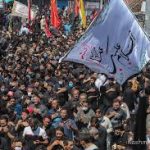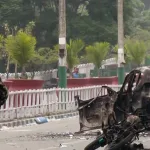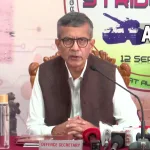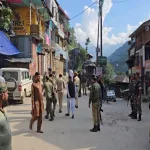In 2020 October while reporting from Ladakh after Galwan incident, certain undercurrents in the wider public opinion caught my attention–one was obviously the impact of the India-China conflict on the region; second was the future of Ladakh as a Union Territory after the political reorganization in 2019; and the third was the continuity of the legacy of the ancient Bhuddist institutions in Ladakh and the seat of Dalai Lama. Wherever I went I encountered these!With the 14th Dalai Lama turning 90 on July 6 and announcing that he’ll reincarnate and that his institution will continue, I’m reminded of my visit to Ladakh and I’m inspired to share what ancient institutions like that of the Dalai Lama have meant for the wider region of Jammu, Kashmir and Ladakh and even beyond to what was today’s northern Pakistan and Afghanistan in history.The Dalai Lama in history wasn’t just an individual figure, he represented an institution that drew Buddhist seekers from far and wide just like Nalanada would have once upon a time. This became clear to me after I met a monk in Ladakh who as a child had travelled to Lhasa for Buddhist studies through the arduous but time-tested routes from Leh to Lhasa and had returned immediately after the Chinese Communist Party took over Tibet. His route of return was from Arunachal Pradesh where he had spent three months offering service at a refugee center and then proceeded for a pilgrimage around the Buddhist circuit in India before returning to Ladakh from the Punjab side.
In Ladakh, families had a long tradition of at least one child in the family joining the Buddhist monastery just like families in Punjab had the tradition of nominating the eldest son a Sikh. The local monasteries always functioned under a mother-monastery and the community contributed to the upkeep of these monasteries which had their own land or revenue resources, somewhat like the big temples in south India.
This socio-religious matrix of the Buddhist communities is visible across the Buddhist societies of the Himalayas and the bigger ancient monasteries by virtue of this system held power, influence and resources. Monasteries far and wide in the region also enjoyed age-old connections all linked through routes across such desolate moon-land topography.
The monk’s individual journey was fascinating as it needs grit and courage to travel by foot through such high altitudes. His journey was symbolic to me of a culture and reverence people had for Buddhist institutions in Lhasa. And the fact that there were many before him who had undertaken the same arduous journey throughout centuries speaks volumes about what Lhasa and its institutions including that of Dalai Lama meant for the Himalayan or the trans-himalayan communities.Incidentally such journeys were possible because these communities lived on ancient routes–Buddhist monks, traders, guides, caravan operators, soldiers–one can call these routes the offshoots of the so-called Silk route. Even today if you stand in downtown Leh in the old market, somewhere near the Police Station, near where was an old sarai of the Uyghur traders, any Ladakhi grandfather can effortlessly explain to you which route came from Khotan and Khasghar, which from Tibet, which from Kashmir via Kargil and which went to Amritsar from Leh through Himachal.They all came and met at today’s downtown Leh market. They hold in their memories many invisible footprints and untold stories of life, survival, disaster and enlightenment. And the idea of human birth, karma and misery; spiritual path, enlightenment and reincarnation is deeply ingrained in each of these untold stories.The idea of reincarnation wasn’t just an emotional or religious, conceptual framework, it was actually an operational aspect of Himalayan life because all communities who contributed to the monasteries or were linked to it were also the likely places where reincarnations happened.
Story of Shambhunatha
Like the contemporary Ladakhi monk, the story of Shambhunatha, the first abbot of Hemis monastery also showcases the socio-cultural framework of the Himalayan and the trans-Himalayan societies from many centuries ago.Locals told me that Shambhunatha was a young man, a seeker from Afghanistan who was travelling through these routes connecting Central Asia and Tibet via Ladakh many centuries ago. He met a guru from his past life in Tibet who directed him that he’ll achieve what he’s aspiring at a place with the eight sacred symbols. Shambhunatha finally found those eight symbols on the massive rock that today forms the backdrop of the Hemis monastery on the bank of the river Indus.From Hemis there’s another monastery about an hour uphill that houses a comparatively smaller number of monks and is built around a cave where the Shambhunath is said to have meditated. This cave is decorated with beautiful centuries-old murals including a painting of the Shambhunatha. The monks residing in this monastery call themselves Yogis and are said to be following a different lineage of enlightened monks who came with their own stories of human life and the reincarnations.Locals told me that on rare occasions the 14th Dalai Lama has meditated in the same cave. While I can’t vouch for all that the locals say, coming to where they are today certainly represents a complex array of spiritual-religious beliefs revolving around ancient institutions of Mahayana Buddhism and reincarnations. Once upon a time even the manager of the Hemis monastery was selected by oracles, a system that was abolished a few decades ago.This Buddhist culture in the entire Himalayan and trans-himalayan circuit through which China is building the China Pakistan Economic Corridor in Gilgit-Baltistan and in the intolerable heights of eastern Ladakh where today Indian and Chinese armies stand confronting each other post Galwan or the societies in Arunachal Pradesh, Sikkim and Bhutan speak of the same legacy in some varying shades. Infact with the military confrontation it’s not only the Changpa nomads of Ladakh who have lost their grazing lands to Chinese salami-slicing but certain big regional monasteries as well.If we take into consideration the federated structure of the monasteries running from the Ladakhi grassroots to the head monastery, one can make out how anything ranging from reincarnation, to seasonal religious activities to border confrontation percolates down to the sparsely populated and desolate Ladakhi villages. The same would be the case of other Himalayan communities practising Mahayana Buddhism.
Surviving Institution of Dalai Lama
Put this entire contemporary context in today’s geopolitical matrix involving India and China and you would understand why the Chinese Communist Party wants to appoint its own Dalai Lama. The same context explains what India is facing across its Buddhism practising population in the Himalayas.Anything that the Dalai Lama decides today impacts much more than the territorial boundary of Tibet and the aspirations of Tibetans. It impacts humanity that’s struggling to preserve a way of life that is connected through multiple possibilities of spiritualism and through life beyond death.I remember when the Ambaran Buddhist site from the Kushan period was excavated in Akhnoor region of Jammu, the 14th Dalai Lama had made a visit to the site in 2011. Akhnoor, another ancient civilizational catchment housing the northernmost precinct of Harappan civilization in India was an important point on the ancient Mughal route that connected Central Asia to Punjab from this side of the Indian subcontinent.Akhnoor was connected in history with Sialkot or ancient Sakala, another important historic seat of Buddhism. In fact a lot of Buddhist heritage of this massive region including cross-boundary Punjab, northern Pakistan, Gilgit-Baltistan as well as of Central Asia is today only a thing of the past.
Great institutions like Nalanda are also gone. And Lhasa too is not where the traditional Buddhist studies happen. This leaves behind only the living Dalai Lama as a custodian representing a trans-boundary socio-religious culture and tradition. There’s much that’s at stake through his institution and through his reincarnation.As humanity transitions to the possibilities of the mid-century let’s appreciate the possibilities that the Dalai Lama’s institution represents.
(The Author is a senior journalist and a MOFA 2025 Taiwan fellow)








